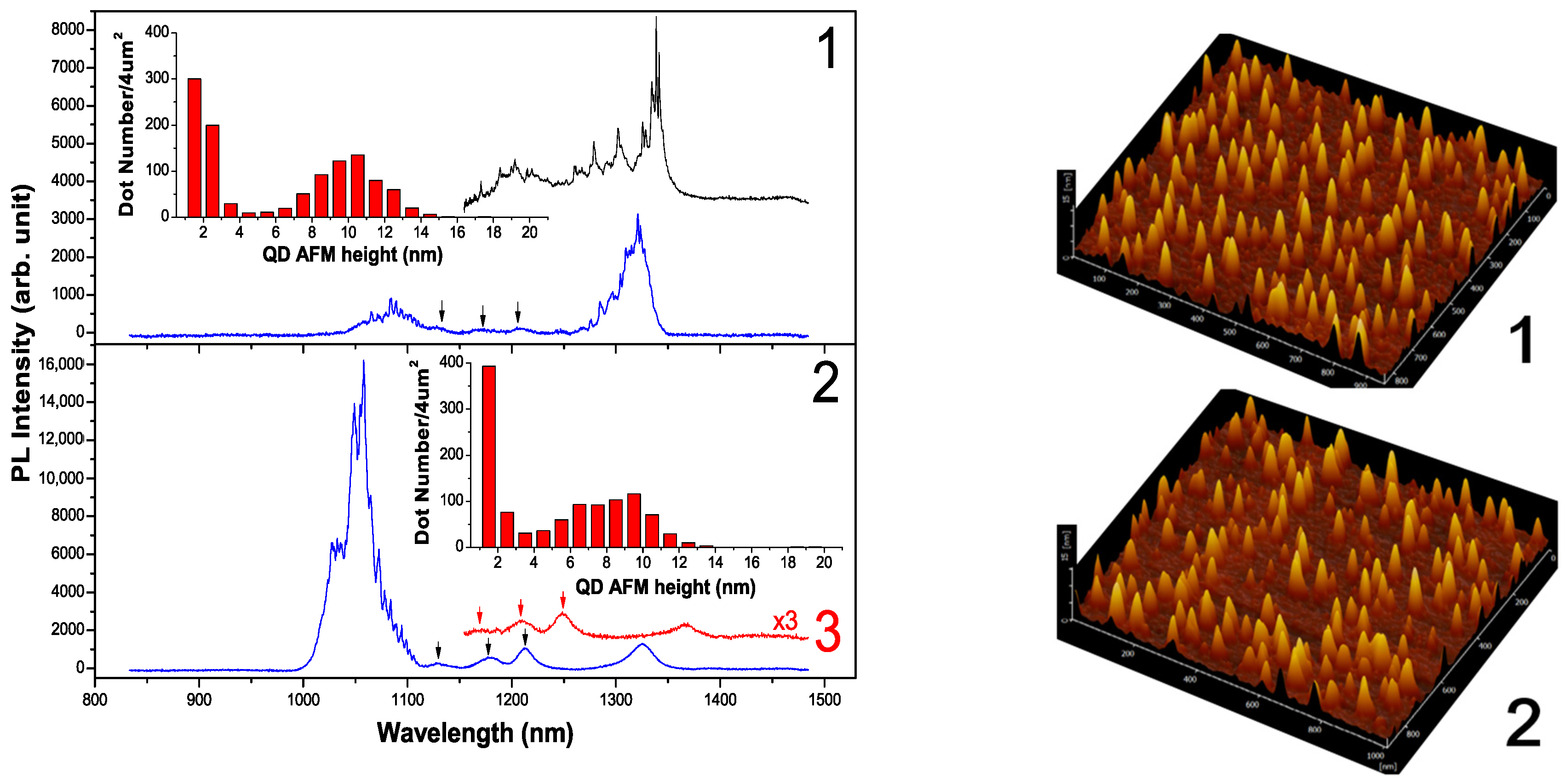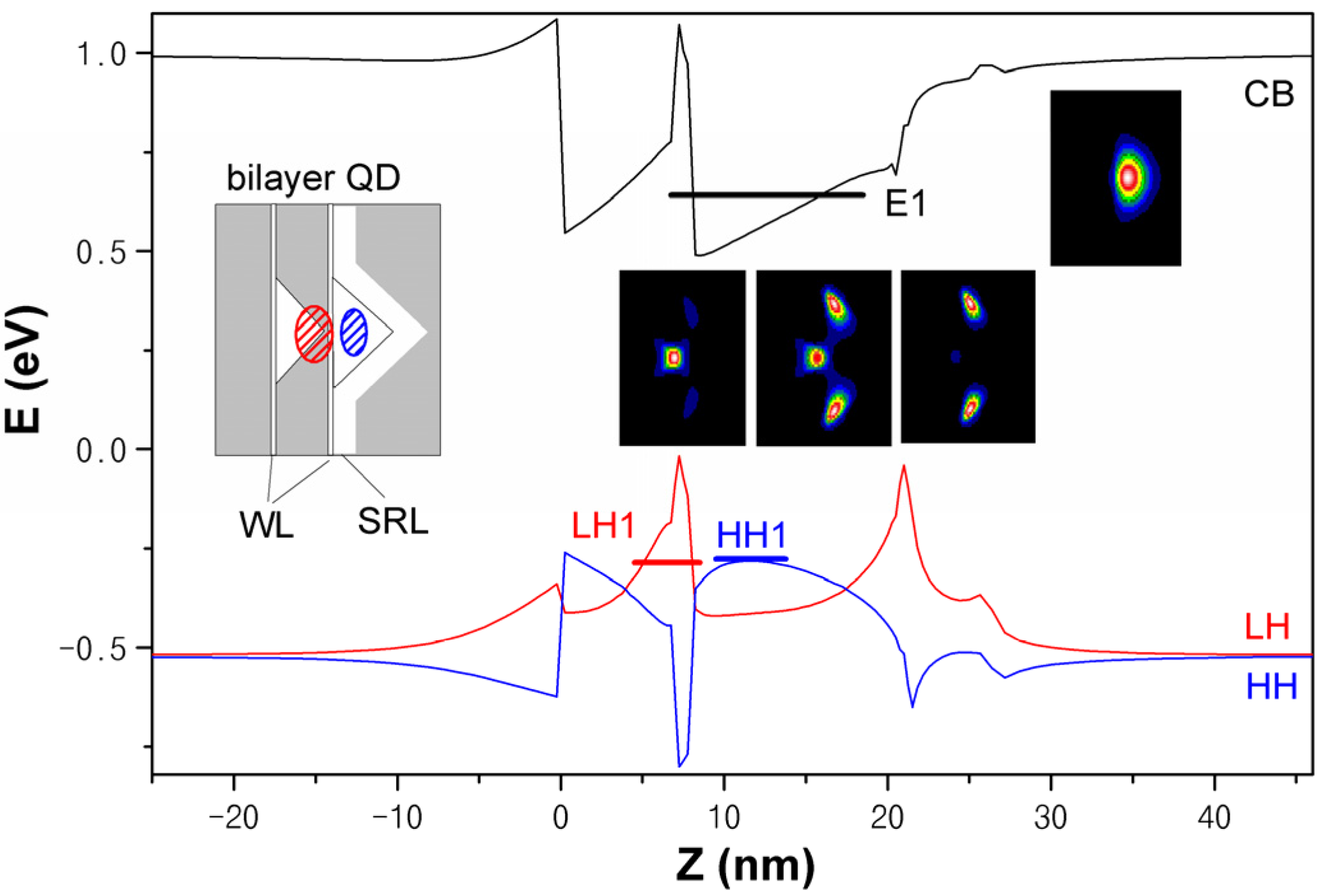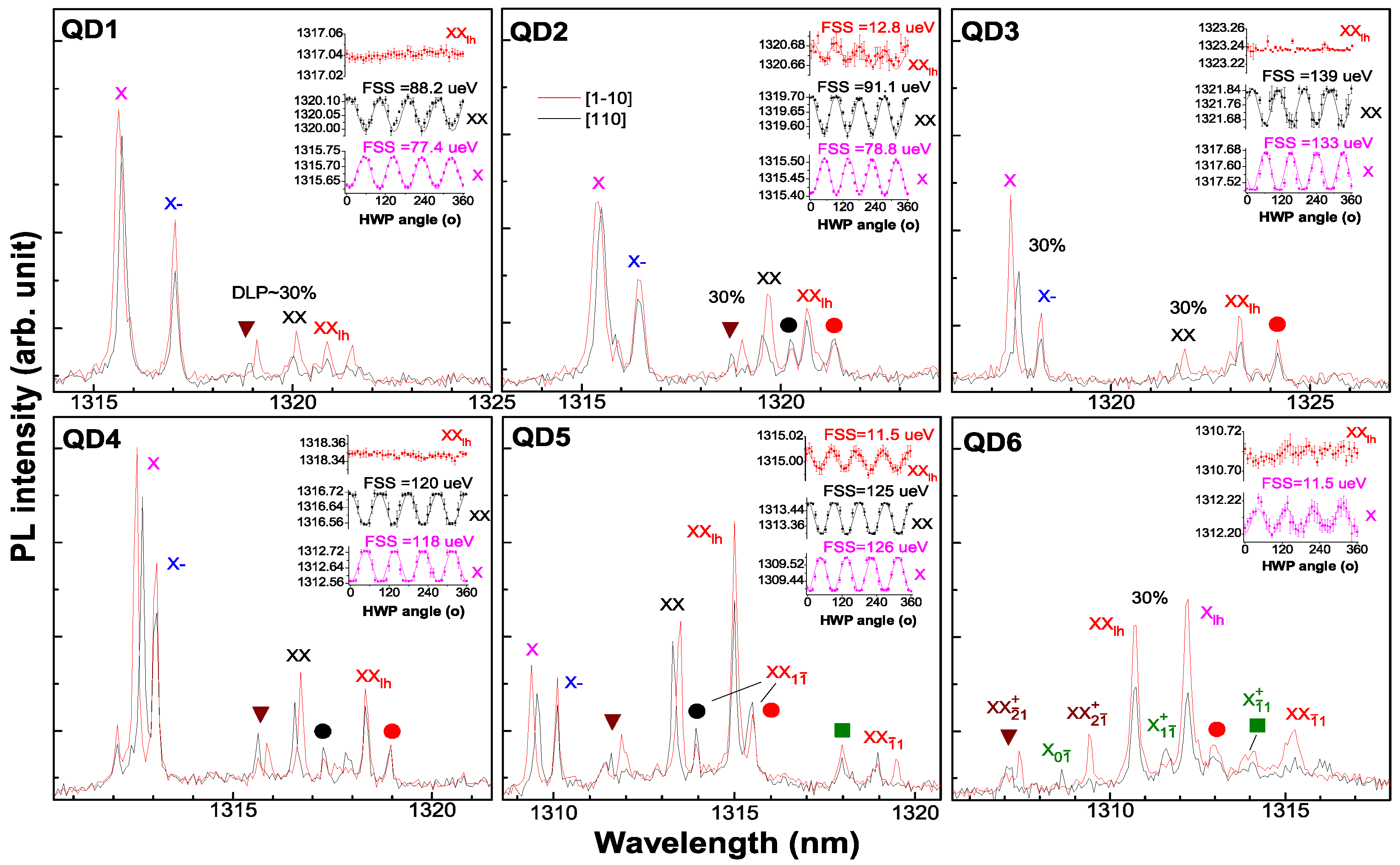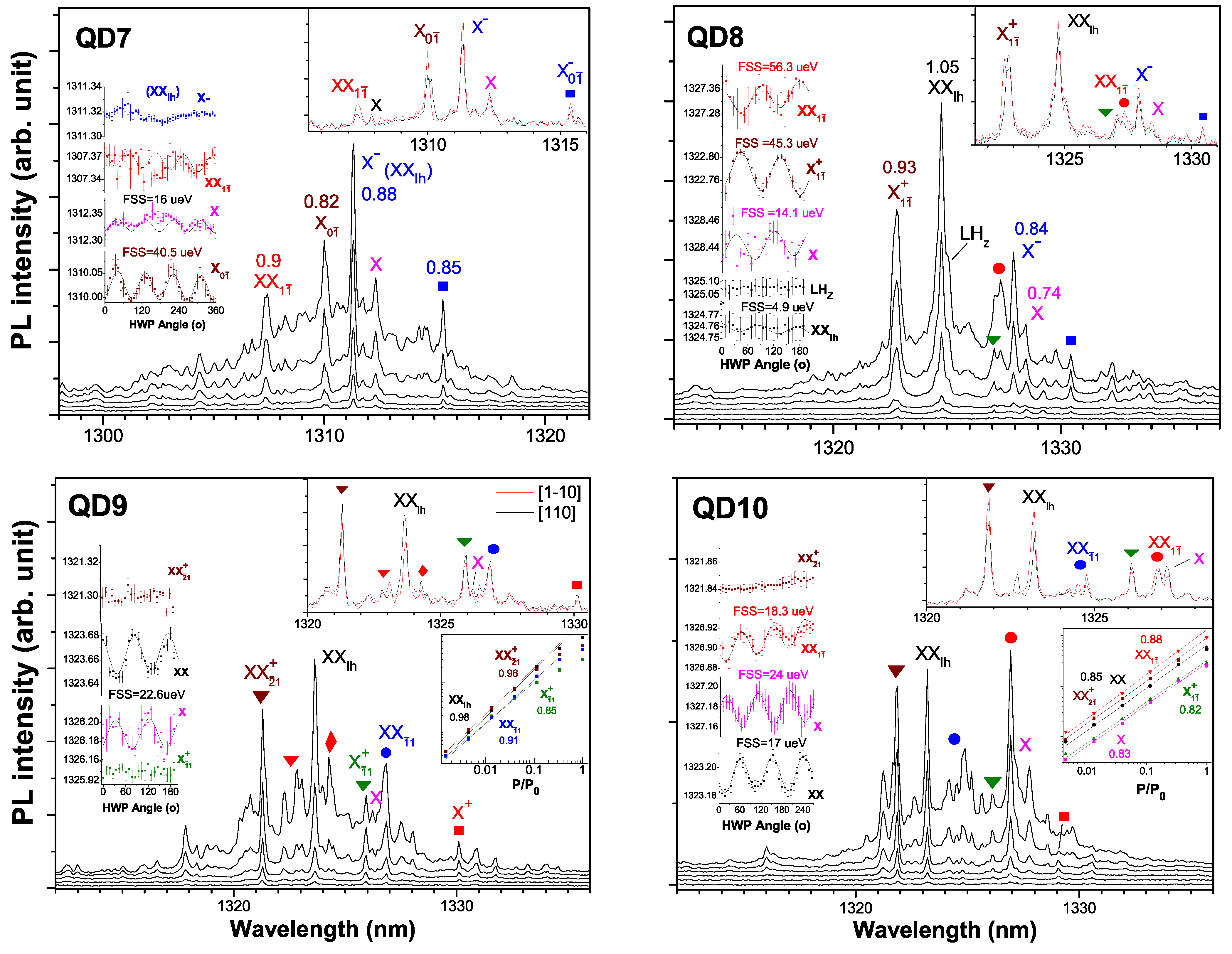Light Hole Excitons in Strain-Coupled Bilayer Quantum Dots with Small Fine-Structure Splitting
Abstract
1. Introduction
2. Materials and Methods
3. Results
3.1. PL Spectra and AFM Images of Bilayer QDs
3.2. Band Structure of Bilayer Single QD
3.3. QDs with Strain-Induced Large FSS
3.4. QDs with LH Excitons in Small FSS
4. Conclusions
Author Contributions
Funding
Institutional Review Board Statement
Informed Consent Statement
Data Availability Statement
Conflicts of Interest
References
- Huffaker, D.L.; Park, G.; Zou, Z.; Shchekin, O.B.; Deppe, D.G. 1.3 um room-temperature GaAs-based quantum-dot laser. Appl. Phys. Lett. 1998, 73, 2564. [Google Scholar] [CrossRef]
- Chen, S.; Li, W.; Wu, J.; Jiang, Q.; Tang, M.; Shutts, S.; Elliott, S.; Sobiesierski, A.; Seeds, A.; Ross, I.; et al. Electrically pumped continuous-wave III–V quantum dot lasers on silicon. Nat. Photon. 2016, 10, 307–311. [Google Scholar] [CrossRef]
- Liu, H.C.; Gao, M.; McCaffrey, J.; Wasilewski, Z.R.; Fafard, S. Quantum dot infrared photodetectors. Appl. Phys. Lett. 2001, 78, 79. [Google Scholar] [CrossRef]
- Shang, X.-J.; Li, S.-L.; Liu, H.-Q.; Su, X.-B.; Hao, H.-M.; Dai, D.-Y.; Li, X.-M.; Li, Y.-Y.; Gao, Y.-F.; Dou, X.-M.; et al. Single- and Twin-Photons Emitted from Fiber-Coupled Quantum Dots in a Distributed Bragg Reflector Cavity. Nanomaterials 2022, 12, 1219. [Google Scholar] [CrossRef]
- Chen, Y.; Li, S.-L.; Shang, X.-J.; Su, X.-B.; Hao, H.-M.; Shen, J.-X.; Zhang, Y.; Ni, H.-Q.; Ding, Y.; Niu, Z.-C. Fiber coupled high count-rate single-photon generated from InAs quantum dots. J. Semicond. 2021, 42, 072901. [Google Scholar] [CrossRef]
- Bauer, S.; Wang, D.; Hoppe, N.; Nawrath, C.; Fischer, J.; Witz, N.; Kaschel, M.; Schweikert, C.; Jetter, M.; Portalupi, S.L.; et al. Achieving stable fiber coupling of quantum dot telecom C-band single-photons to an SOI photonic device. Appl. Phys. Lett. 2012, 119, 211101. [Google Scholar] [CrossRef]
- Pooley, M.A.; Ellis, D.J.P.; Patel, R.B.; Bennett, A.J.; Chan, K.H.A.; Farrer, I.; Ritchie, D.A.; Shields, A.J. Controlled-NOT gate operating with single photons. Appl. Phys. Lett. 2012, 100, 211103. [Google Scholar] [CrossRef]
- Papon, C.; Zhou, X.-Y.; Thyrrestrup, H.; Liu, Z.; Stobbe, S.; Schott, R.; Wieck, A.D.; Ludwig, A.; Lodahl, P.; Midolo, L. Nanomechanical single-photon routing. Optica 2019, 6, 524. [Google Scholar] [CrossRef]
- Huo, Y.H.; Rastelli, A.; Schmidt, O.G. Ultra-small excitonic fine structure splitting in highly symmetric quantum dots on GaAs (001) substrate. Appl. Phys. Lett. 2013, 102, 152105. [Google Scholar] [CrossRef]
- Chen, Z.-S.; Ma, B.; Shang, X.-J.; He, Y.; Zhang, Y.L.-C.; Ni, H.-Q.; Wang, J.-L.; Niu, Z.-C. Telecommunication Wavelength-Band Single-Photon Emission from Single Large InAs Quantum Dots Nucleated on Low-Density Seed Quantum Dots. Nanoscale Res. Lett. 2016, 11, 382. [Google Scholar] [CrossRef][Green Version]
- Sapienza, L.; Malein, R.N.; Kuklewicz, C.E.; Kremer, P.E.; Srinivasan, K.; Griffiths, A.; Clarke, E.; Gong, M.; Warburton, R.J.; Gerardot, B.D. Exciton fine-structure splitting of telecom-wavelength single quantum dots: Statistics and external strain tuning. Phys. Rev. B 2013, 88, 155330. [Google Scholar] [CrossRef]
- Sittig, R.; Nawrath, C.; Kolatschek, S.; Bauer, S.; Schaber, R.; Huang, J.; Vijayan, P.; Pruy, P.; Portalupi, S.L.; Jetter, M.; et al. Thin-film InGaAs metamorphic buffer for telecom C-band InAs quantum dots and optical resonators on GaAs platform. Nanophotonics 2022, 11, 1109. [Google Scholar] [CrossRef]
- Shang, X.-J.; Xu, J.-X.; Ma, B.; Chen, Z.-S.; Wei, S.-H.; Li, M.-F.; Zha, G.-W.; Zhang, L.-C.; Yu, Y.; Ni, H.-Q.; et al. Proper In deposition amount for on-demand epitaxy of InAs/GaAs single quantum dots. Chin. Phys. B 2016, 25, 107805. [Google Scholar] [CrossRef]
- Kuroda, T.; Mano, T.; Ha, N.; Nakajima, H.; Kumano, H.; Urbaszek, B.; Jo, M.; Abbarchi, M.; Sakuma, Y.; Sakoda, K.; et al. Symmetric quantum dots as efficient sources of highly entangled photons: Violation of Bell’s inequality without spectral and temporal filtering. Phys. Rev. B 2013, 101, 041306. [Google Scholar] [CrossRef]
- Liang, S.; Zhu, H.L.; Ye, X.L.; Wang, W. Effect of GaAs (100) 2o surface misorientation on the formation and optical properties of MOCVD grown InAs quantum dot. Appl. Surf. Sci. 2006, 252, 8126. [Google Scholar] [CrossRef]
- Shriram, S.R.; Kumar, R.; Panda, D.; Saha, J.; Tongbram, B.; Mantri, M.R.; Gazi, S.A.; Mandal, A.; Chakrabarti, S. Study on Inter Band and Inter Sub-Band Optical Transitions With Varying InAs/InGaAs Sub-Monolayer Quantum Dot Heterostructure Stacks Grown by Molecular Beam Epitaxy. IEEE Trans. Nanotechnol. 2020, 19, 601. [Google Scholar] [CrossRef]
- Shang, X.-J.; Li, S.-L.; Liu, H.-Q.; Ma, B.; Su, X.-B.; Chen, Y.; Shen, J.-X.; Hao, H.-M.; Liu, B.; Dou, X.-M.; et al. Symmetric Excitons in an (001)-Based InAs/GaAs Quantum Dot Near Si Dopant for Photon-Pair Entanglement. Crystal 2021, 11, 1194. [Google Scholar] [CrossRef]
- Shang, X.-J.; Ma, B.; Ni, H.-Q.; Chen, Z.-S.; Li, S.-L.; Chen, Y.; He, X.-W.; Su, X.-L.; Shi, Y.-J.; Niu, Z.-C. C2v and D3h symmetric InAs quantum dots on GaAs (001) substrate: Exciton emission and a defect field influence. AIP Adv. 2020, 10, 085126. [Google Scholar] [CrossRef]
- Fathpour, S.; Mi, Z.; Bhattacharya, P. High-speed quantum dot lasers. J. Phys. D Appl. Phys. 2005, 38, 2103. [Google Scholar] [CrossRef]
- Thompson, S.E.; Armstrong, M.; Auth, C.; Cea, S.; Chau, R.; Glass, G.; Hoffman, T.; Klaus, J.; Ma, Z.; Mcintyre, B.; et al. A Logic Nanotechnology Featuring Strained-Silicon. IEEE Electron Device Lett. 2004, 25, 191. [Google Scholar] [CrossRef]
- William, E.K.; Pancholi, A.; Stoleru, V.G. Quantum dot molecules: A potential pathway towards terahertz devices. Phys. E Low-Dimens. Syst. Nanostruct. 2006, 35, 139. [Google Scholar]
- Belhadj, T.; Amand, T.; Kunold, A.; Simon, C.-M.; Kuroda, T.; Abbarchi, M.; Mano, T.; Sakoda, K.; Kunz, S.; Marie, X.; et al. Impact of heavy hole-light hole coupling on optical selection rules in GaAs quantum dots. Appl. Phys. Lett. 2010, 97, 051111. [Google Scholar] [CrossRef]
- Zhang, J.-X.; Huo, Y.-H.; Rastelli, A.; Zopf, M.; Höfer, B.; Chen, Y.; Ding, F.; Schmidt, O.G. Single photons On-demand from light-hole excitons in strain-engineered quantum dots. Nano. Lett. 2015, 15, 422. [Google Scholar] [CrossRef]
- Beirne, G.J.; Hermannstadter, C.; Wang, L.; Rastelli, A.; Schmidt, O.G.; Michler, P. Quantum Light Emission of Two Lateral Tunnel-Coupled (In, Ga)As/GaAs Quantum Dots Controlled by a Tunable Static Electric Field. Phys. Res. Lett. 2006, 96, 137401. [Google Scholar] [CrossRef] [PubMed]
- Chen, Z.-S.; Ma, B.; Shang, X.-J.; Ni, H.-Q.; Wang, J.-L.; Niu, Z.-C. Bright single-photon source at 1.3 um based on InAs bilayer quantum dot in micropillar. Nanoscale Res. Lett. 2017, 12, 378. [Google Scholar] [CrossRef]
- Li, S.-L.; Shang, X.-J.; Chen, Y.; Su, X.-B.; Hao, H.-M.; Liu, H.-Q.; Zhang, Y.; Ni, H.-Q.; Niu, Z.-C. Wet-etched microlens array for 200 nm spatial isolation of epitaxial single QDs and 80 nm broadband enhancement of their quantum light extraction. Nanomaterials 2021, 11, 1136. [Google Scholar] [CrossRef] [PubMed]
- Li, M.-F.; Yu, Y.; He, J.-F.; Wang, L.-J.; Zhu, Y.; Shang, X.-J.; Ni, H.-Q.; Niu, Z.-C. In situ accurate control of 2D-3D transition parameters for growth of low-density InAs/GaAs self-assembled quantum dots. Nanoscale Res. Lett. 2013, 8, 86. [Google Scholar] [CrossRef] [PubMed]
- Alloing, B.; Zinoni, C.; Li, L.H.; Fiore, A.; Patriarche, G. Structural and optical properties of low-density and In-rich InAs/GaAs quantum dots. J. Appl. Phys. 2007, 101, 024918. [Google Scholar] [CrossRef]
- Yamaguchi, T.; Tawara, T.; Kamada, H.; Gotoh, H.; Okamoto, H.; Nakano, H.; Mikami, O. Single-photon emission from single quantum dots in a hybrid pillar microcavity. Appl. Phys. Lett. 2008, 92, 081906. [Google Scholar] [CrossRef]
- Karlsson, K.F.; Oberli, D.A.; Dupertuis, M.; Troncale, V.; Byszewski, M.; Pelucchi, E.; Rudra, A.; Holtz, P.O.; Kapon, E. Spectral signatures of high-symmetry quantum dots and effects of symmetry breaking. New J. Phys. 2015, 17, 103017. [Google Scholar] [CrossRef]
- Kettler, J.; Paul, M.; Olbrich, F.; Zeuner, K.; Jetter, M.; Michler, P. Neutral and charged biexciton-exciton cascade in near-telecom-wavelength quantum dots. Phys. Rev. B 2016, 94, 045303. [Google Scholar] [CrossRef]
- Carmesin, C.; Olbrich, F.; Mehrtens, T.; Florian, M.; Michael, S.; Schreier, S.; Nawrath, C.; Paul, M.; Höschele, J.; Gerken, B.; et al. Structural and optical properties of InAs/(In)GaAs/GaAs quantum dots with single-photon emission in the telecom C-band up to 77 K. Phys. Rev. B 2016, 98, 125407. [Google Scholar] [CrossRef]
- Trotta, R.; Zallo, E.; Ortix, C.; Atkinson, P.; Plumhof, J.D.; van den Brink, J.; Rastelli, A.; Schmidt, O.G. Universal Recovery of the Energy-Level Degeneracy of Bright Excitons in InGaAs Quantum Dots without a Structure Symmetry. Phys. Rev. Lett. 2012, 109, 147401. [Google Scholar] [CrossRef]





Publisher’s Note: MDPI stays neutral with regard to jurisdictional claims in published maps and institutional affiliations. |
© 2022 by the authors. Licensee MDPI, Basel, Switzerland. This article is an open access article distributed under the terms and conditions of the Creative Commons Attribution (CC BY) license (https://creativecommons.org/licenses/by/4.0/).
Share and Cite
Shang, X.; Liu, H.; Su, X.; Li, S.; Hao, H.; Dai, D.; Chen, Z.; Ni, H.; Niu, Z. Light Hole Excitons in Strain-Coupled Bilayer Quantum Dots with Small Fine-Structure Splitting. Crystals 2022, 12, 1116. https://doi.org/10.3390/cryst12081116
Shang X, Liu H, Su X, Li S, Hao H, Dai D, Chen Z, Ni H, Niu Z. Light Hole Excitons in Strain-Coupled Bilayer Quantum Dots with Small Fine-Structure Splitting. Crystals. 2022; 12(8):1116. https://doi.org/10.3390/cryst12081116
Chicago/Turabian StyleShang, Xiangjun, Hanqing Liu, Xiangbin Su, Shulun Li, Huiming Hao, Deyan Dai, Zesheng Chen, Haiqiao Ni, and Zhichuan Niu. 2022. "Light Hole Excitons in Strain-Coupled Bilayer Quantum Dots with Small Fine-Structure Splitting" Crystals 12, no. 8: 1116. https://doi.org/10.3390/cryst12081116
APA StyleShang, X., Liu, H., Su, X., Li, S., Hao, H., Dai, D., Chen, Z., Ni, H., & Niu, Z. (2022). Light Hole Excitons in Strain-Coupled Bilayer Quantum Dots with Small Fine-Structure Splitting. Crystals, 12(8), 1116. https://doi.org/10.3390/cryst12081116






